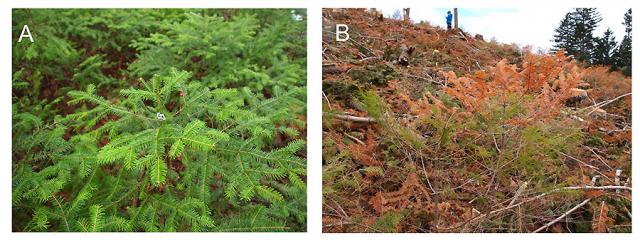Home > Research > Research Results > Research Results 2018 > Preserving tree shade during winter trimming is important for protecting Abies sachalinensis seedlings from sunburn
Update:October 22, 2018
Main content starts here.
Preserving tree shade during winter trimming is important for protecting Abies sachalinensis seedlings from sunburn
| Article title |
Springtime photoinhibition constrains regeneration of forest floor seedlings of Abies sachalinensis after a removal of canopy trees during winter |
|---|---|
| Author (affiliation) |
Mitsutoshi Kitao (a), Hisanori Harayama (a), Qingmin Han (b),Evgenios Agathokleous (a), Akira Uemura (a), Naoyuki Furuya (a), Satoshi Ishibash (a) (a) Hokkaido Research Center, FFPRI, Sapporo, Hokkaido, Japan. |
| Publication Journal |
Scientific Reports、8:6310、April 2018, DOI:10.1038/s41598-018-24711-6( External link ) |
| Content introduction |
Child trees (seedlings) of Abies sachalinensis, an important afforestation species in Hokkaido, can survive even in the dark forest environment. In the eastern part of Hokkaido in particular, many seedlings can be found in A. sachalinensis forests because of lower amounts of accumulated snow and less presence of the exuberant Sasa bamboo. In Hokkaido, A. sachalinensis trees in forests are generally trimmed during winter. During this trimming, can naturally growing seedlings in the forest be used for post-trimming natural forest regeneration (regeneration of the forest through natural emergence of seedlings without using artificial planting)? We cut A. sachalinensis trees at various rates during winter to investigate the relationship between photoinhibition and growth of A. sachalinensis seedlings in varying light environments. Here photoinhibition refers to “sunburn of leaves.” In the spring survey, leaves of seedlings grown in the forest trimmed at a higher rate (i.e., brighter environment) were strongly affected by photoinhibition. In the summer survey, many leaves were found to be healthy, but the elongation of branches was lower at the site with stronger photoinhibition (brighter site). This is attributable to falling of damaged leaves or reduced photosynthetic capacity. These findings indicate that it is important to protect seedlings from “strong light” by, for example, retaining some canopy trees (mother trees) to facilitate post-trimming natural regeneration of A. sachalinensis. |
Copyright © Forest Research and Management Organization. All rights reserved.

